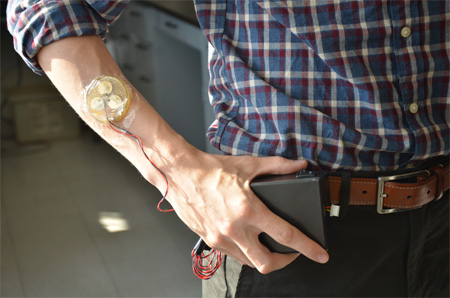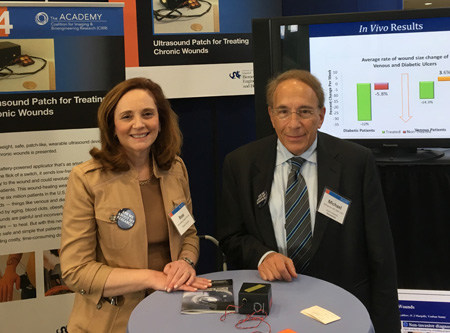Clinical Trial to Test Wound-Healing Device
Drexel University researchers are one step closer to offering a new treatment for the millions of patients who suffer from slow-healing, chronic wounds. The battery-powered applicator — as small and light as a watch — is the first portable and potentially wearable device to heal wounds with low-frequency ultrasound.
The National Institutes of Health awarded the research team an estimated $3 million to test the therapy on 120 patients over the next five years. By using diagnostic monitoring of blood flow in the wound tissue, the clinical trial will also determine how nutrition and inflammation impact wound closure, making treatment customization a possibility.

This battery-powered applicator — as small and light as a watch — is the first portable and potentially wearable device to heal wounds with low-frequency ultrasound.
The project is an interdisciplinary collaboration between the College of Medicine and Drexel's School of Biomedical Engineering, Science and Health Systems, and College of Nursing and Health Professions.
Chronic wounds affect up to 6 million patients a year in the United States. Venous ulcers — one type of chronic wound the researchers are exploring — are caused by abnormal vein function, due to blood clots, injury, aging and obesity. Chronic wounds are also one of the most dangerous and common complications of diabetes. Unlike a typical scrape or cut, venous and diabetic ulcers can take months, or even years, to heal. The currently available therapies are passive, rather than active, such as using products to keep moisture in place.
Because of their high prevalence, chronic wounds are a significant economic burden to the U.S. health care system. Over $20 billion annually is spent on the treatment of chronic wounds in the United States, according to some estimates. Treatment can cost an individual patient up to $2,400 per month, so even modest reductions in healing time would help, according to Michael S. Weingarten, MD, professor of surgery at the College of Medicine and medical director of the Comprehensive Wound Healing Program at Drexel.
"There is a lot of money being spent on wound supplies, visiting nurses and things like that. Those costs can run into the hundreds of thousands of dollars for an individual patient," Weingarten says. "And if the wound isn't responding, then you're really just wasting your time, and more importantly, you're not helping the patient."
Drexel biomedical engineers, including project lead researcher Peter Lewin, PhD, and clinicians have an ideal solution: an inexpensive, portable instrument that can speed up slow-healing injuries and is safe enough for patients to use at home.
The device heals by sending low-frequency — 20 kilohertz (kHz) — ultrasonic sound waves directly to the chronic wound. While the healing potential of ultrasound to reduce swelling in injury is well known, high energy levels are not optimal for treating damaged tissue over long periods of time.

A National Showcase
Surgeon Michael S. Weingarten and colleagues were invited to Washington to present their ultrasound wound-healing technology at the annual Medical Imaging Technology Showcase hosted by the Coalition for Imaging and Bioengineering Research. Held on Capitol Hill, the event brings together "the best of academia, industry and patient-focused research" to educate legislators and their staffs about new technologies and how they affect patient outcomes.
Weingarten and Rose Ann DiMaria-Ghalili, PhD, of the College of Nursing and Health Professions, had the opportunity to show off Drexel's innovative device — a wearable patch that uses ultrasound to speed the wound-healing process — directly to policymakers, other scientists, patient groups and industry partners.
The wound-healing technology — and its potential impact on one patient — was also featured in a WTXF-TV (FOX-29) news segment (fox29.com/news/229993065-video).
The device the Drexel team has developed operates at a level of energy much lower than, for example, the ultrasound units used to monitor pregnancy. Once the device is fully developed, the applicator may be applied directly to the wound using a thin piece of Tegaderm, gel and medical tape. Then, with the flip of a switch, the palm-sized battery pack is turned on, driving the set of transducers inside the device to create acoustic energy and begin the wound-healing process.
In 2013, the researchers successfully tested the device on 20 patients from Weingarten's wound-healing clinic. Applying the ultrasound at a frequency of 20 kHz for 15-minute intervals proved to be the most effective combination of energy and duration. All five patients in the group who received this combination of treatment had healed completely by the end of the four-week treatment period. Overall, the study demonstrated that the new treatment improved healing by 15 percent per week compared to the placebo.
To monitor the wound-healing process in the new study, the researchers are employing near-infrared technology, also developed at Drexel, to measure blood vessel growth and tissue oxygenation. Depending on what the optic data tell them about how well a wound is healing, the researchers could increase or decrease the treatment time or frequency for the patient.
In addition, faculty from the College of Nursing and Health Professions are collecting health data from the patients, including information about diet and nutritional intake, to determine how those factors, as well as inflammation, could contribute to chronic wound closure.
Results from the group's preliminary studies give the researchers confidence that the ultrasound device will accelerate closure of chronic wounds with a much larger group of patients. If they can prove efficacy and safety during the Phase II clinical trial, in which they will monitor 120 patients during a 16-week period, then they will treat an even larger cohort in a third clinical trial.
Back to Top